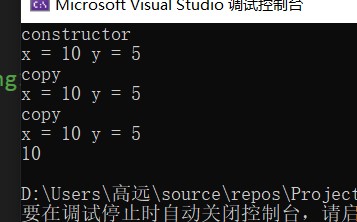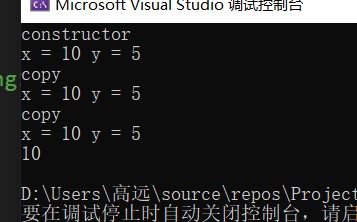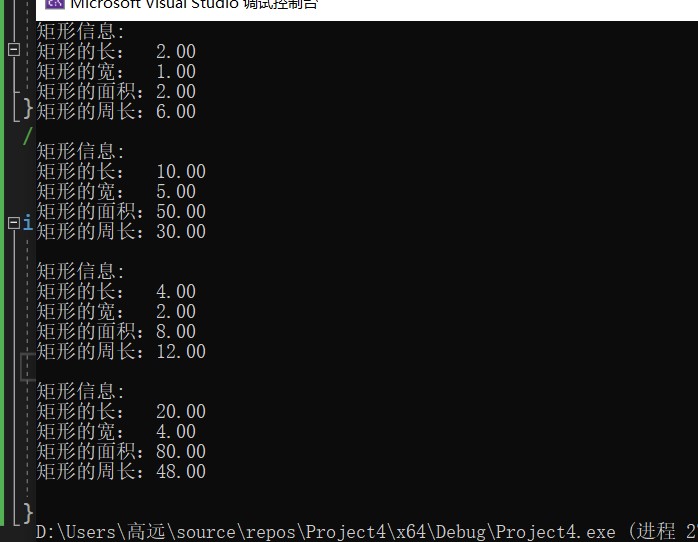实验1 类和对象(1) 高远
1 #include <iostream> 2 #include <vector> 3 #include <string> 4 using namespace std; 5 int main() { 6 string s1; 7 string s2{ "c ++" }; 8 string s3{ s2 }; 9 string s4 = s2; 10 s1 = "oop"; 11 vector<string> v1; 12 v1.push_back(s1); 13 v1.push_back(s2 + "2"); 14 v1.push_back(s3 + "3"); 15 v1.push_back(s4 + "4"); 16 17 cout << "output" << endl; 18 for (auto item : v1) { 19 cout << item << endl; 20 } 21 cout << "ouput2: " << endl; 22 for (auto p = v1.begin(); p != v1.end(); ++p) 23 cout << *p << endl; 24 25 cout << "3" << endl; 26 for (auto a = 0; a < v1.size(); ++a) 27 cout << v1[a] << endl; 28 vector<string> v2{ v1.rbegin(), v1.rend() }; 29 cout << "v2: " << endl; 30 for (auto item : v2) 31 cout << item << endl; 32 return 0; 33 34 }

#include <iostream> #include <string> #include <vector> #include <cmath> #include <cstdlib> #include <time.h> using namespace std; template<typename T> void output(const T& obj) { for (auto item : obj) cout << item << ","; cout << endl; } int main() { vector<int> v1{ 1, 2, 3, 4 }; v1.insert(v1.begin(), 2022); v1.insert(v1.end(), 2023); output(v1); v1.pop_back(); v1.erase(v1.begin()); output(v1); vector<string> v2{ "gaoyuan","nuist" }; output(v2); return 0; }

#include <iostream> using namespace std; class Point { public: Point(int x0 = 0, int y0 = 0); Point(const Point& p); ~Point() = default; int get_x() const { return x; } int get_y() const { return y; } void show() const; private: int x, y; }; Point::Point(int x0, int y0) : x(x0), y(y0) { cout << "constructor" << endl; } Point::Point(const Point& p) : x(p.x), y(p.y) { cout << "copy" << endl; } void Point::show() const { cout << "x = " << x << " " << "y = " << y << endl; } int main() { Point p1(10, 5); p1.show(); Point p2 = p1; p2.show(); Point p3{ p2 }; p3.show(); cout << p3.get_x() << endl; return 0; }

#include <iostream> #include <iomanip> using namespace std; class Clock { public: Clock(int h = 0, int m = 0, int s = 0); Clock(const Clock& c); void set_time(int h, int m = 0, int s = 0); void show_time() const; private: int hour, min, sec; }; Clock::Clock(int h , int m , int s ) :hour(h), min(m), sec(s) { cout << "constructor" << endl; }; Clock::Clock(const Clock& c) : hour(c.hour), min(c.min), sec(c.sec) { cout << "copy" << endl; } void Clock::set_time(int h, int m , int s ) { hour = h; min = m; sec = s; } Clock reset() { return Clock(4, 0, 5); } void Clock::show_time() const { cout << setfill('0') << setw(2) << hour << " :" << setw(2) << min << ":" << setw(2) << sec; } int main() { Clock my_clock(2, 9, 12); my_clock.show_time(); Clock new_clock = reset(); new_clock.show_time(); Clock c3(my_clock); c3.set_time(2); c3.show_time(); return 0; }

#include <iostream> using namespace std; class X { public: X(); ~X(); X(int m); X(const X& obj); X(X&& obj) noexcept; void show()const; private: int data; }; X::X() : data{ 42 } { cout << "construct default " << endl; } X::~X() { cout << "destroy" << endl; } X::X(int m) :data(m) { cout << "constructor" << endl; } X::X(const X& obj) : data(obj.data) { cout << "copy" << endl; } X::X(X&& obj) noexcept : data(obj.data) { cout << "move" << endl; } void X::show() const { cout << data << endl; } int main() { X x1; x1.show(); X x2{ 2049 }; x2.show(); X x3{ x1 }; x3.show(); X x4{ std::move(x2) }; x4.show(); }

主函数第一步类对象x1调用默认函数,data = 42,然后show()函数调用。
初始化类对象x2,调用构造函数,data = 2049,然后show()函数调用。
初始化类对象x3,首先调用复制函数,
初始化类对象x4调用移动函数。
运行完主函数的return 0 之后,调用析构函数4次。
#include <iostream> #include <iomanip> using namespace std; // 矩形类Rectangle的定义和实现 // 补足代码 // ××× class Rectangle { public: Rectangle(); Rectangle(double l, double w); Rectangle(Rectangle& p); ~Rectangle(); double len() const { return length; } double wide() { return width; } double area(); double circumstance(); void resize(double times); void resize(double ltimes, double wtimes); void output(); private: double length, width; }; Rectangle::Rectangle() : length(2.0), width(1.0) {}; Rectangle::Rectangle(double l,double w) : length(l), width(w) {}; Rectangle::Rectangle(Rectangle& p) : length(p.length), width(p.width) {}; Rectangle::~Rectangle() = default; double Rectangle::area() { return width * length; } double Rectangle::circumstance() { return (length + width) * 2; } void Rectangle::resize(double times) { length *= times; width *= times; } void Rectangle::resize(double ltimes, double wtimes) { length *= ltimes; width *= wtimes; } // 普通函数, 用于输出矩形信息 void Rectangle::output() { using namespace std; cout << "矩形信息: \n"; cout << fixed << setprecision(2); // 控制输出格式:以浮点数形 cout << "矩形的长: " << left << setw(6) << len() << endl; cout << "矩形的宽: " << left << setw(6) << wide() << endl; cout << "矩形的面积:" << left << setw(6) << area() << endl; cout << "矩形的周长:" << left << setw(6) << circumstance() << endl; cout << endl; // 补足代码:分行输出矩形长、宽、面积、周长 // ××× } // 主函数,测试Rectangle类 int main() { Rectangle rect1;// 默认构造函数被调用 rect1.output(); Rectangle rect2(10, 5);// 带有两个参数的构造函数被调用 rect2.output(); Rectangle rect3(rect1);// 复制构造函数被调用 rect3.resize(2); // 矩形rect3的长和宽同时缩放2倍 rect3.output(); rect3.resize(5, 2);// 矩形rect3的长缩放5倍, 宽缩放2倍 rect3.output(); }



